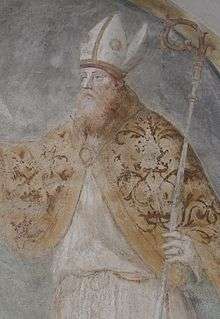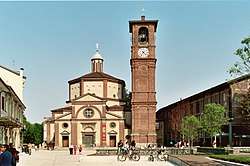Magnus (bishop of Milan)
Magnus (Italian: Magno) was Archbishop of Milan from 518 to c. 530. He is honoured as a saint in the Catholic Church.[1]
Magnus | |
|---|---|
| Archbishop of Milan | |
 | |
| Church | Catholic Church |
| Appointed | 518 AD |
| Term ended | c. 530 |
| Predecessor | Eustorgius II |
| Successor | Dacius |
| Personal details | |
| Died | c. 530 |
| Sainthood | |
| Feast day | November 5 |
| Venerated in | Catholic Church |
| Shrines | Basilica of Saint Magnus in Legnano |
Life
Almost nothing is known about the life and the episcopate of Magnus.[2] Magnus lived under the Arian king Theodoric the Great, who probably at first supported him, but later persecuted him as had already happened for the philosopher Boethius.[3]
What is known is the text of his funeral epitaph, transmitted us by Goffredo da Bussero (13th century), which describes Magnus as a man of great charity who helped the prisoners of war.[4]
Magnus died in 530, on 1 December. His remains were interred in the Basilica of Sant'Eustorgio in Milan.[1] A late tradition, with no historical basis, associates Magnus with the Milanese family of the Trincheri.
Veneration

The first formal survey on his relics was made in 1248 by the Domenicans who ministered to the Basilica of Sant'Eustorgio in Milan. The main church of the town of Legnano, about 20 km (12 mi) from Milan, is dedicated to Magnus. The Basilica di San Magno of Legnano was built between 1503 and 1513 and a part of relics of Magnus were translated there on 5 November 1900.[5] His feast is celebrated on November 5 in that basilica; all the saint bishops of Milan are celebrated on 25 September.
Notes
- Majo, Angelo (1989). "Magno, santo (518-530 c.)". Dizionario della Chiesa Ambrosiana. 3. Milano: NED. p. 1844. ISBN 88-7023-102-X.(in Italian)
- Ruggeri, Fausto (1991). I Vescovi di Milano. Milano: NED. p. 16. ISBN 88-7023-154-2.(in Italian)
- "La vita di San Magno vescovo". Contrada San Magno. Archived from the original on 25 April 2012. Retrieved 28 October 2011.(in Italian)
- Cazzani, Eugenio (1996). Vescovi e arcivescovi di Milano. Milano: Massimo. pp. 31–32. ISBN 88-7030-891-X.(in Italian)
- "Guida alla visita della Basilica di San Magno". Parrocchia San Magno. Archived from the original on 16 November 2011. Retrieved 28 October 2011.(in Italian)
| Wikimedia Commons has media related to Magnus. |